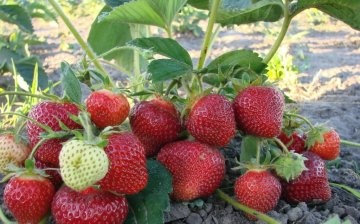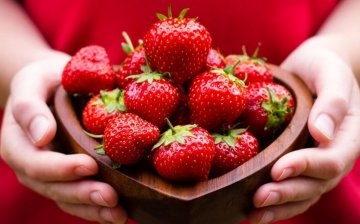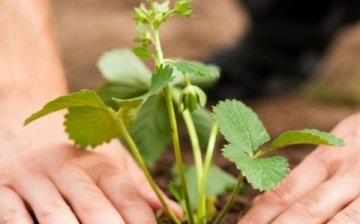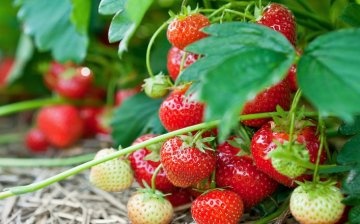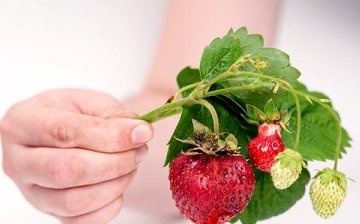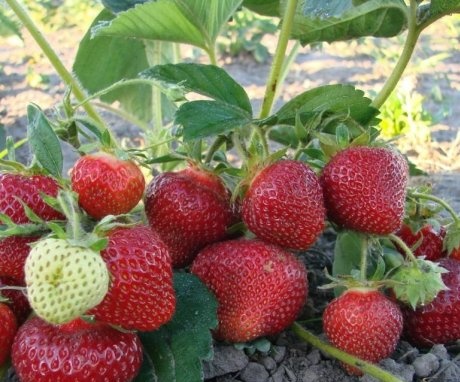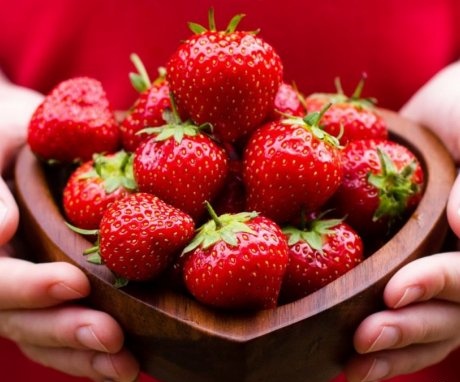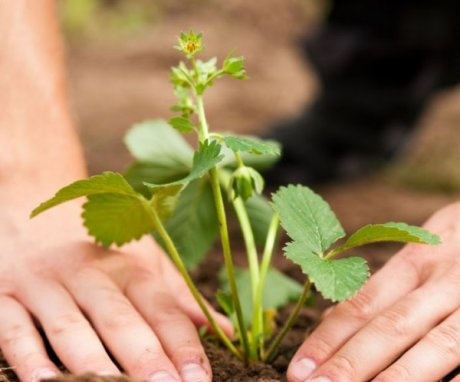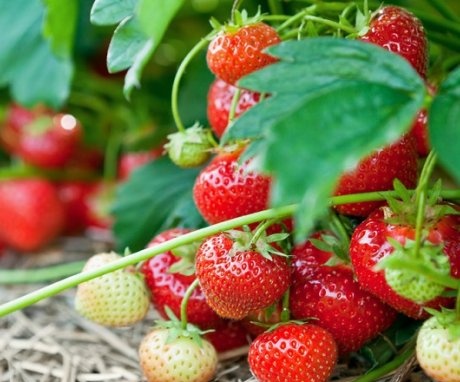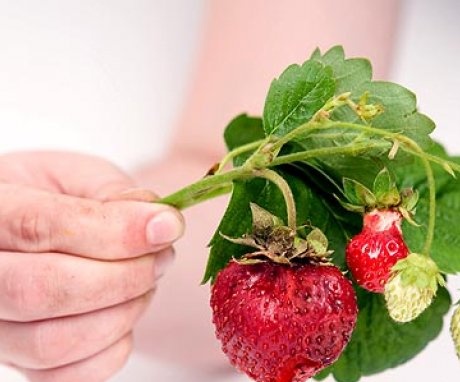Remaining strawberry varieties: an overview of the best
Strawberries are a fragrant early summer berry, one of the few that both kids and adults adore. In the markets, they ask for fabulous sums for it, and I really want to pamper myself with an indescribable taste.
Therefore, many gardeners are trying to plant at least a small bed on their site, but their own, red droplets of strawberries. In gardening, a large number of different species and varieties are distinguished. The most popular is repair strawberry.
Content:
- Repair strawberry - what is it, what is the feature
- Review of the best varieties
- Planting repair strawberries
- Care Tips
- Diseases and pests
Repair strawberry - what is it, what is the feature
Repair strawberry is a variety of garden strawberries, which are distinguished by constant fruiting. The weight of individual berries can vary from 3-4 grams. up to 90-100 gr. The flowering of a plant is most often recorded by 2-3 harvests; natural conditions do not allow for a larger amount. Such a plant has the ability to supply red fruits all summer.
The first flowering of strawberries occurs on average in May and lasts until September.
It is recommended to cut the last inflorescences, since the berries do not have time to set and ripen, thereby further weakening the bush. The only drawback of the species is that only the first harvest, obtained in late May-early June, is able to surprise with a large number of berries or large volumes of fruit. Subsequent fruiting produces berries either in smaller numbers or smaller in size. It all depends on the variety (small-fruited or large-fruited).
However, neither size nor abundance diminishes the popularity of the plant. This is due to the fact that the late harvest is much richer and tastier, small children especially love it. Also, autumn berries are good for harvesting for the winter in conservation or for freezing.
Strawberry repaired varieties are no different from ordinary plants: it also grows well in the first spring sunbeams, it perfectly develops both the root system and the lush green foliage. It is not afraid of frost - the leaves boldly hibernate under the snow. But the inflorescences that did not have time to tie in time die at the first frost, already at a temperature of -10C. It is worth noting that remontant strawberries are not durable. Constant fruiting is very exhausting bushes. Strong mother bushes can live 3-4 years in one place without transplanting, but on condition that special care and timely feeding will be carried out for them.
Review of the best varieties
If it is decided to plant a remontant plant on the site, then first you need to familiarize yourself with the possible varieties and choose the best. Among the whole variety of different varieties of strawberries, it is worth highlighting the difference in the reproduction of bushes - with the help of a mustache or dividing rhizomes.
Mustacheless varieties are most often represented by small-fruited berries:
- Ali Baba - the bushes are powerful, partly spreading, the leaves are elongated in height by 15 cm. A fairly large number of inflorescences are thrown out. The berries emit a unique forest aroma. Fruits are conical in shape, with a deep red hue. The weight of the berries is insignificant - 3-5 grams, but they stand out for their high yield, immunity to drought and frost, and are also not afraid of pests and diseases.
- Forest Fairy Tale - the bushes are small, compact, giving out many flowers, which are constantly raging. The fruits are slightly elongated, endowed with a sweet and sour aftertaste, the weight of the berries is 5 g.
- Ruyana - the greenery on the bush is formed very compactly. Fruits are distinguished among other varieties by their large size. Berries can boast of early ripening (2 weeks earlier than other types). Strawberries are distinguished by a bright red tone and a rich smell of wild strawberries from the forest. The plant has a high yield, does not suffer from diseases, calmly refers to the drought of hot summers and cold winters.
- Baron Solemacher - the mass of its fruits reaches 4 grams, they are clearly visible due to their bright red color. The berries taste sweet and tasty, there is no sourness in them. Strawberries are distinguished by small convex blotches, as well as great resistance to pests.
- Rugen is a dessert type of strawberry with bloody-scarlet fruits of an elongated character. It tastes sweet enough. It produces flower stalks together with the beginning of leaf growth (in early April), and accordingly bears fruit early enough.
Species that form many whiskers, and are also famous for large berries, are called large-fruited. Among them, the best representatives are distinguished:
- Albion - strawberries of a closely red hue, sweet taste, with a dense inner content, tolerates transportation well, does not depend on weather and diseases.
- Queen Elizabeth - the bushes are not endowed with large foliage, but the greens are fleshy, powerful. Fruits weighing 50 to 125 grams, the pulp is juicy and sweet, outwardly - raspberry tone. Strawberry one year old - a new bush should be planted for the next period.
- Temptation - differs in taste (nutmeg flavor), the weight of the berries is 30 grams, the pulp is juicy, but dense. The first fruits can be obtained in May.
- Moscow Delicacy - greens are strong, vigorous, abundant yield, weight - from 15 to 35 grams. Has an interesting aftertaste - it resembles a sweet cherry. Not afraid of frost and immune to disease.
Thus, the varieties are all interesting and multifaceted. In order to determine exactly which one is most suitable, it is recommended to plant several types at a time. Then choose one that you want to multiply.
Planting repair strawberries
Planting is carried out before winter - from late August to early October. Then the plant manages to take root in the ground before the onset of the first frost and will please it with the harvest next year.
The first step is to prepare the planting material. The mother bush produces a large number of whiskers. Of these, you should choose the 3 most powerful ones, cut the rest. Antennae of the first order are planted in plastic cups, without cutting off from the bush. All other shoots are removed.
After the sprout has given its own roots (they are clearly visible through the ground), the tendril is carefully disconnected.
Landing features:
- For planting in open ground, choose a light, not darkened area. It is desirable that the soil is medium loamy, neutral acidity. About 30 days before transplanting, the soil should be prepared.
- Removed weeds, top dressing is applied in the form of humus or compost (per 1 m2 - 5 kg.), As well as saltpeter (25 gr.), superphosphate (70 gr.), potassium salt (30 gr.). Everything is carefully dug to a depth of 15-20 cm.
- The prepared seedlings are well watered the day before planting so that the substrate comes out well from its old place. A hole is dug on the ground, into which a whole lump of earth is placed, it should not be shaken off from the roots.
- So the bush will not even feel the transshipment and will not hurt and take root. The distance between the seedlings should be about 20 cm, and the row spacing should be 60 cm. This will allow the strawberries to grow and start up replacement tendrils.
Care Tips
It is recommended to plant the plant either in the evening after sunset, or on a cloudy, rainy day. Proper care of strawberries includes procedures:
- Abundant watering during flowering and fruiting.
- Loosening the soil and sawdust mulching or straw.
- Removal of weeds, extra whiskers, old leaves.
- Timely feeding.
- Spraying with solutions from diseases and pests.
- Protecting bushes for the winter with fallen leaves, pine needles or straw.
After planting, young animals regularly need watering, feeding is not yet required - everything you need is already contained in the substrate. Loosening is necessary as the soil is washed out. not only allows water to flow to the roots faster, but also the earth is saturated with oxygen, which is extremely necessary for the qualitative development of the root system. Loosening is done carefully so as not to damage either antennae or roots.
In order not to loosen often, there is an option - to mulch the aisles with sawdust, peat or dried grass.
Top dressing of remontant varieties is simply a must. The event is held at least 3 times a year: until the rapid growth of greenery (mullein), during flowering (chicken droppings, saltpeter or ash), after harvesting (nitroammophos).
Diseases and pests
Pests and diseases also affect strawberries any kind. The most common ailments of the red berry:
- Gray rot - caused by a fungus that manifests itself due to high humidity (with abundant and excessive watering, during the rainy season). Fruits acquire small brown spots, and then become covered with a fluffy white bloom. To avoid infection, spraying with copper oxychloride is performed, and damaged fruits are immediately removed, while the bushes are thinned out.
- Powdery mildew - harms the leaves, they become brown and curl. Sick plants are dug up and burned, and the still undamaged seedlings are sprayed with potassium permanganate or colloidal sulfur.
- Brown spot - destroys foliage, it becomes brown and falls off. Irrigation with copper chloride is required, which is carried out after harvest.
In addition to diseases, pests can attack the plant, they are no less terrible than diseases. There are such insects:
- The strawberry mite is the most dangerous enemy, it attacks the leaves. They curl up and turn yellow, and the seedling itself stops developing. After harvesting, it is required to douse the foliage with a solution of karbofos.
- Aphid - is located on the flowers and the back of the leaves. To remove the insect, sprinkle with a mixture of wood ash and laundry soap.
Prevention should be carried out both in spring and autumn. Good care and control of the condition will rid the plant of intruders. Thus, a strawberry that yields a crop several times differs from an ordinary plant only in the period of fruiting and the period of viability. When choosing a particular variety, you need to be sure of its reliability and productivity.
More information can be found in the video:




